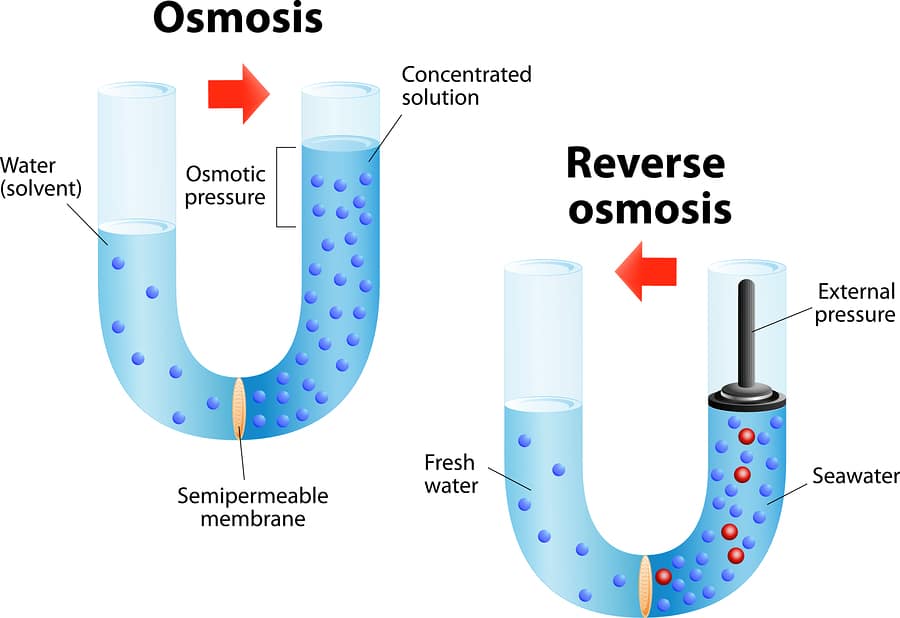Jacksonville Reverse Osmosis Systems
How do reverse osmosis water filtration systems work?
If you’ve been drinking bottled water at your home, you are already aware of the condition of tap water in Jacksonville. Did you know your tap water can produce the same clean, pure and refreshing bottled-water-taste by installing a reverse osmosis system?
If you’ve never taken a sip from a glass of water that came from the home of someone with a reverse osmosis system, you are in for quite a surprise. Along with tasting great, reverse osmosis systems ensure the water your family prepares food and cooks with is free from contaminants.
Reverse osmosis (R.O.) drinking water truly is the purest choice for any home. It’s water the way nature intended us to drink it. But how exactly do these systems work, and what do they do to your home’s water?
What is Reverse Osmosis?
Osmosis is defined as the process of molecules passing through a semi-permeable membrane from a less-concentrated solution into a more-concentrated solution.
Reverse osmosis is simply the opposite of that process.

Osmosis – diffusion of fluid through a semipermeable membrane from a solution with a low solute concentration to a solution with a higher solute concentration. Reverse osmosis is a water purification technology
The Reverse Osmosis Process

How Reverse Osmosis Filtration Works
There’s a bit more to the process when using a reverse osmosis system to purify drinking water.
Step 1: Pre-filtration
The first step in purifying water with reverse osmosis is meant to protect the membrane. It removes larger sediment, including some dissolved solids, and helps reduce chlorine.
This sediment filter or carbon block filter helps conserve the membrane, which can get clogged by excess sediment or damaged by exposure to too much chlorine, which you’ll find in municipal water.
Reverse osmosis works best when you start with good water and then make it great. That’s why you should never use a reverse osmosis system with hard water unless it is under 10 grains per gallon. If your water is hard, start with one of our water softener solutions.
We recommend having a water softener installed before installing an R.O. system. Scale buildup from hard water can damage these systems in the same way they damage other appliances.
Step 2: The Reverse Osmosis Membrane
Following the initial filtration comes the real magic of a reverse osmosis system.
Your water is forced through the semi-permeable membrane under pressure. The membrane is a synthetic plastic material that allows the passage of water molecules. However, sodium, chlorine, and calcium as well as larger molecules like glucose, urea, bacteria and viruses cannot pass.
The WaterMaker Five reverse osmosis systems has been tested and certified for reduction of:
- lead
- arsenic
- copper
- nitrates and nitrites
- chromium (hexavalent & trivalent)
- selenium
- fluoride
- radium
- barium
- cadmium
- cyst (cryptosporidium)
- total dissolved solids (TDS)
Steps 3 & 4: Post Filtration and Final Polish
Before your home’s water is ready to drink, it goes through a second carbon filter (or post filter), which removes any remaining contaminants in the unlikely case they slipped past the membrane.
Then the water fills up a storage tank where it waits until you’re ready to use it.
Finally, there’s the in-line activated carbon filter, which gives your water one last polish as it makes its way to your faucet. This last step removes any remaining odors and/or flavor.
The polish is a “just in case” step to make sure the water you drink tastes incredibly fresh!
Is Reverse Osmosis Drinking Water Right for Your Home?
Soft water is excellent for cleaning, showering, and laundry. However, some people would rather not drink it. Depending on how hard your water is to start with, it could still have high total dissolved solids (TDS), which can negatively affect the taste. That’s because the hard minerals are replaced by sodium, and there may be other contaminants in your water that a softener will not remove.
A reverse osmosis system can remove that sodium along with other contaminants and dissolved solids, which makes a water softener and an R.O. system an ideal combination for most homes.
When you install a reverse osmosis system, you’ll enjoy pure, healthy water right from your kitchen sink. If you’re still using bottled water for drinking, you’ll be making a smart investment that saves you money in the long run and is better for the environment.
Reverse osmosis systems are commonly installed under kitchen sinks. If desired, we also offer whole home R.O. systems. So you can even wash your car with reverse osmosis water for a spot-free finish!
Learn more about the WaterMaker Five reverse osmosis system here: WaterMaker Five Reverse Osmosis System.
Learn more about CareSoft Water Softeners here: CareSoft Pro Water Softeners.
For those who have serious concerns about water quality or potential contamination, you can have your water tested at our Clean Water Testing center to get the answers you need.



